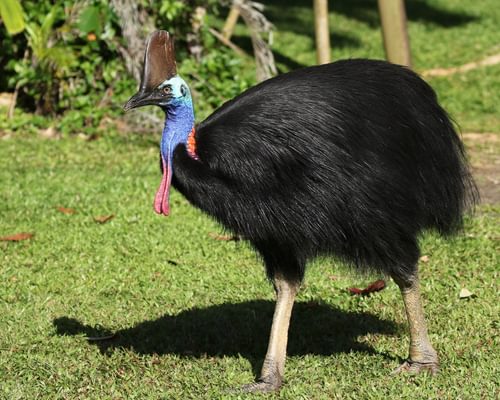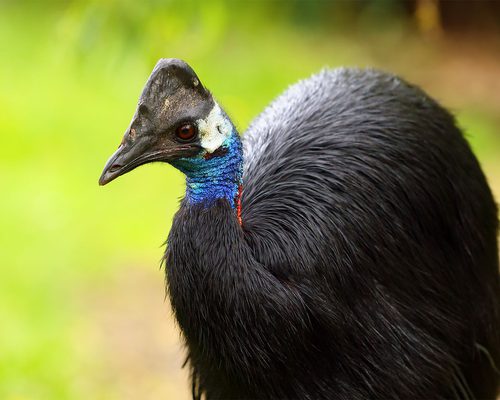Northern Cassowary
Casuarius unappendiculatus
Visual Identification
Appearance
The Northern Cassowary is a striking, flightless bird with glossy black plumage and a vibrant blue head and neck. Its most distinctive feature is a large, horn-like casque atop its head, alongside a single red wattle hanging from its throat.
Both sexes look similar, with females slightly larger. Juveniles have brown plumage, lacking the bright colours and developed casque of adults.
Size
Length
165cm to 175cm
Wingspan
40cm to 50cm
Weight
29kg to 58kg
Colours
Males and females have similar plumage
Primary Colour
Black Blue
Secondary Colour
Red Yellow Orange
Beak Colour
Grey
Leg Colour
Grey
Habitat and Distribution
Habitats
Woodland
Garden
Wetland
Coastal
Urban
Farmland
Grassland
Desert
Tundra
Rainforest
Mountain
Savanna
Distribution
Northern Cassowaries inhabit the lowland rainforests of New Guinea, primarily in the northern and western regions of the island. They're also found on the nearby islands of Yapen and Salawati.
These birds prefer dense, humid forests but may venture into swamp forests and occasionally mangrove areas. They're non-migratory, maintaining year-round territories within their range.
Elevation Range
Sea level to 700 meters
Climate zones
Tropical
Distribution Map
This map gives you a rough idea of where you might spot a Northern Cassowary. The coloured areas show countries where these birds have been seen.
A few things to keep in mind:
- Birds might not be everywhere in the coloured areas, for example, they may be present around the coast of that country
- Where birds live can change with seasons and available food
- This map is quite simple - it doesn't show exact locations
We're working on making our maps even better! Soon, we hope to show you:
- More detailed maps for bigger countries, including state and region
- How birds move around during different seasons
Distribution by Region
Behaviour and Ecology
Bird Attributes
This feature is in beta. We'd love your feedback to improve it!
Share your thoughtsBird Attributes Explained
Our bird attributes system rates various aspects of a bird's capabilities on a scale of 0-100, based on data from field observations, scientific studies, and expert knowledge.
Attribute Categories:
- Agility: Manoeuvrability, speed, and grace in flight or movement.
- Strength: Physical power, often correlating with size and hunting abilities.
- Adaptability: Ability to thrive in various environments or changing conditions.
- Aggressiveness: Territorial behaviour and assertiveness, particularly during breeding seasons.
- Endurance: Stamina, often seen in migration patterns or foraging behaviours.
Understanding the Ratings:
- 0-20: Very Low
- 21-40: Low
- 41-60: Average
- 61-80: High
- 81-100: Very High
Remember, these attributes are relative to other bird species and don't necessarily indicate superiority.
Hover over the icon next to each attribute for more information.
Tap the icon next to each attribute for more information.
Agility
Reflects the bird's manoeuvrability, speed, and grace in flight or movement.
The Northern Cassowary demonstrates remarkable agility, capable of running up to 50 km/h through dense forest. Its ability to navigate complex rainforest environments and swim across rivers showcases its impressive manoeuvrability.
Strength
Indicates the bird's physical power, often correlating with size and hunting abilities.
With powerful legs capable of delivering potentially lethal kicks and a robust build weighing up to 58 kg, the Northern Cassowary possesses formidable strength. Its ability to defend against most predators and move through dense vegetation underscores its physical prowess.
Adaptability
Represents the bird's ability to thrive in various environments or changing conditions.
While primarily adapted to lowland rainforests, the Northern Cassowary shows some adaptability by venturing into swamp forests, mangrove areas, and even coastal waters. However, its specific habitat requirements and vulnerability to deforestation suggest limitations in adaptability.
Aggressiveness
Measures the bird's territorial behaviour and assertiveness, particularly during breeding seasons.
Known as one of the most dangerous birds, the Northern Cassowary exhibits high aggression when threatened. Its territorial nature, powerful defensive kicks, and the need to observe from a safe distance all indicate a notably aggressive disposition.
Endurance
Reflects the bird's stamina, often seen in migration patterns or foraging behaviours.
The Northern Cassowary's ability to patrol large territories daily, swim across rivers, and maintain year-round activity in tropical climates suggests considerable endurance. Its size and flightless nature, however, may impose some limitations on long-term stamina compared to migratory birds.
Diet
Northern Cassowaries are primarily frugivorous, consuming a wide variety of fallen fruits. They play a crucial role in seed dispersal for many rainforest plants. Their diet is supplemented with small vertebrates, invertebrates, and fungi when available.
Behaviour
Northern Cassowaries are solitary and territorial, patrolling their home ranges daily. They're known for their powerful kicks, capable of seriously injuring potential threats. These birds are excellent swimmers, often crossing rivers and venturing into coastal waters.
Vocalisation
Northern Cassowaries are known for their deep, booming calls, which can be heard up to a kilometre away. These low-frequency vocalisations, often described as a rumbling 'boom-boom-boom,' are used for communication and territorial displays. They also produce hisses and grunts when alarmed.
Nesting & Breeding
Breeding occurs year-round, with peak activity during the dry season. Males attract females with low-frequency booming calls and vibrant displays of their wattles and neck colours.
Females lay 3-5 large, pale green eggs in a simple ground nest of leaves and plant material. The male is solely responsible for incubation, which lasts about 50 days.
After hatching, the male cares for the chicks for up to 9 months, protecting them and teaching foraging skills. Young cassowaries reach sexual maturity at about three years of age.
Conservation and Status
Global Conservation Status
Although the Northern Cassowary is classified as Least Concern, they face threats from habitat loss from deforestation and hunting. Conservation efforts focus on protecting remaining rainforest habitats and implementing stricter hunting regulations in their range.
Birdwatching Tips
- Look for them in dense, lowland rainforests
- Listen for their low-frequency booming calls
- Observe from a safe distance, as they can be aggressive when threatened
- Search for their large, three-toed footprints in muddy areas
Additional Information
Quick Facts
Other names:
Single-wattled Cassowary
Family:
CasuariidaeAverage Lifespan
18 to 20 years
Max Lifespan
61 years [4]
Predators
Adult Northern Cassowaries have few natural predators due to their size and defensive capabilities. However, eggs and chicks may fall prey to large pythons, monitor lizards, and feral pigs.
Did You Know?
- Northern Cassowaries can run up to 50 km/h (31 mph) through dense forest.
- Their casque may act as a resonating chamber for their low-frequency calls.
- They're considered one of the most dangerous birds on the planet due to their powerful kicks.
- Captive Northern Cassowaries have been reported to live for at least 61 years, with another at least 48 years old.
Similar Birds
References
- 1 3
website: BirdLife International. 2017. Casuarius unappendiculatus. The IUCN Red List of Threatened Species 2017: e.T22678114A118134784.
View source - 2 4
report, 2016: G. Dutson in litt.
Share Your Feedback
We value your opinion! Let us know what you think about this bird page.

